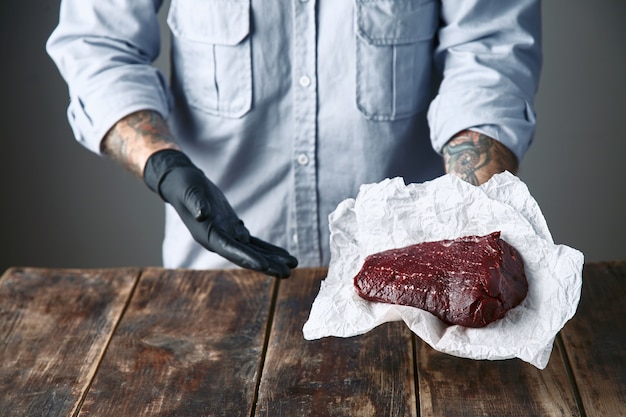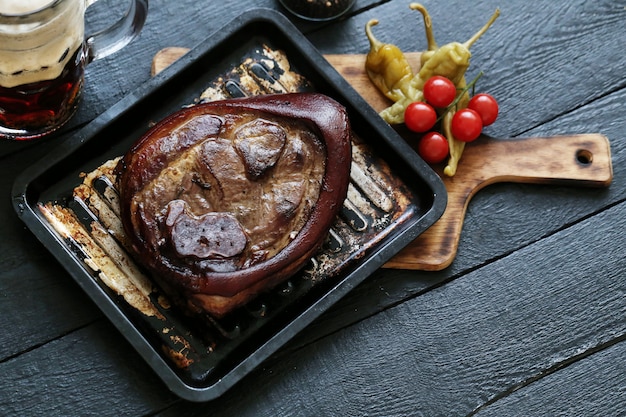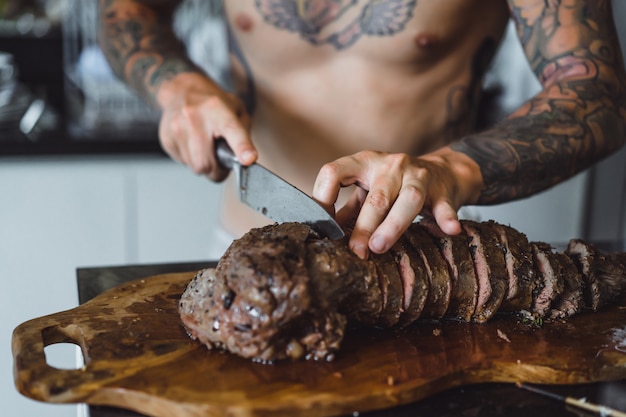You’ve got a hankering for a succulent, juicy ribeye roast, but you're not sure where to start? Don’t worry, you’ve come to the right place! As a seasoned home cook with a deep appreciation for perfectly cooked meat, I've spent years honing my ribeye roasting skills. Now, I'm excited to share my secrets with you, from picking the perfect cut to achieving that irresistible, golden-brown crust. Get ready to impress your family and friends with a meal that's truly unforgettable.
This guide isn't just about tossing a ribeye in the oven and calling it a day. It's about embracing the whole process, from the initial selection of your meat to the final, glorious carving. We'll cover everything from basic techniques to more advanced methods, like reverse searing, to ensure your ribeye roast is cooked to perfection every single time. Ready to dive in?
(Part 1) choosing the right cut:

The Art of Selecting a prime ribeye
Let's face it: the foundation of a delicious ribeye roast starts with the right cut of meat. You wouldn’t build a house on shaky ground, would you? It's the same principle with your ribeye. You want a piece of meat that's marbled with a beautiful balance of fat and lean meat. This marbling is like the secret ingredient – it adds flavour and keeps the meat juicy during cooking, giving you that tender, melt-in-your-mouth experience.
Don't shy away from a bit of conversation with your butcher. They're your allies in this quest for the perfect ribeye! Ask them for their recommendations, let them know your desired level of marbling, and whether you prefer a bone-in roast for that extra flavour. Trust me, a good butcher can point you towards a cut that will elevate your entire meal.
Understanding the Grades: From Select to Prime
Now, you'll see different grades on those ribeye roasts, and it's important to understand what they mean. They tell you how much marbling the meat has, and therefore, how much flavour you can expect.
- Select: This is the most basic grade, with the least amount of marbling. It's not really ideal for roasting, as it can turn out dry and tough. You'll probably want to stick with something higher for a satisfying roast.
- Choice: This is the most common grade, offering a good balance of flavour and tenderness. It's a good choice for a roast, but don't expect the same level of marbling as Prime.
- Prime: This is the top of the line, boasting the most marbling and a richer, more luxurious flavour. Think of it as the steak superstar. It's the ultimate choice for a ribeye roast that will leave everyone speechless.
While Prime is undoubtedly the best, it comes with a price tag to match. If you're working with a budget, Choice can still provide a delicious meal, especially if you choose a well-marbled roast. You can also talk to your butcher about finding deals on Prime, sometimes they have special cuts or promotions.
(Part 2) Preparing the Roast:

Now that you have your prized ribeye, it's time to get it ready for the oven. Here's how to prepare it for a culinary masterpiece:
Patting It Dry: For a Crispy Crust
The first step is to pat the roast dry with paper towels. This might seem like a small detail, but it's crucial for achieving that gorgeous, crispy crust. Moisture on the surface of the meat will prevent it from browning properly, leaving you with a less-than-ideal finish.
The Art of Seasoning: A Symphony of Flavour
Here's where we start to unleash the flavour potential of your ribeye. There are countless ways to season a roast, but here's my tried-and-true method, the one I always fall back on:
- Salt: This is the star of the show. Generously season with kosher salt. Salt's magic lies in its ability to draw moisture out of the meat, then draw it back in during cooking. This creates a juicier, more flavorful roast. Don't be shy; embrace the salt!
- Black Pepper: Freshly ground black pepper adds a sharp bite and depth of flavour. It's the counterpoint to the salt, adding complexity to your seasoning blend.
- Garlic Powder: This brings a subtle, earthy flavour that complements beef so well. It's a classic addition that elevates the taste of your roast.
- Onion Powder: A touch of onion powder adds another layer of savoury depth to your seasoning mix. It's the secret ingredient that brings everything together.
If you're feeling adventurous, you can explore other herbs and spices. Dried rosemary or thyme create a classic flavour profile. But remember, it's all about personal taste. Experiment and find what you love!
Pro Tip: Season the ribeye liberally and allow it to sit at room temperature for about 30 minutes before cooking. This lets the meat come up to temperature, ensuring it cooks more evenly. This is especially crucial for larger roasts. You want to avoid shocking the meat with sudden heat changes.
(Part 3) Cooking the Ribeye Roast:

This is the grand finale, the moment of truth. You have a few options for cooking your ribeye, each offering a distinct taste and texture. Let's explore them!
Reverse Searing: The Gentle Path to Tenderness
Think of reverse searing as the slow, patient approach to cooking a ribeye. It's all about achieving a tender, juicy roast by cooking it low and slow, followed by a final, intense sear. Here's the breakdown:
- Low and Slow: Preheat your oven to 225°F (110°C). Place the ribeye roast in a roasting pan and cook for about 2-3 hours, or until the internal temperature reaches 125°F (52°C) for medium-rare. The key here is to cook it gently and evenly.
- Rest and Rise: Remove the roast from the oven and let it rest for 30 minutes. This allows the juices to redistribute throughout the meat, making it even more succulent.
- The Final Touch: While the roast is resting, preheat a cast-iron skillet over high heat. Add a tablespoon of oil to the pan and sear the ribeye roast for about 2-3 minutes per side. This creates a beautiful, crispy crust that locks in the flavour.
oven roasting: The Classic Method
This is a tried-and-true method that's perfect for a weeknight dinner. It's straightforward and reliable, delivering a delicious roast every time.
- Preheat and Roast: Preheat your oven to 425°F (220°C). Place the ribeye roast in a roasting pan and cook for 15-20 minutes, or until the internal temperature reaches 125°F (52°C) for medium-rare. Keep a close eye on it, as the temperature can rise quickly at this heat.
- Rest and Enjoy: Remove the roast from the oven and let it rest for 15 minutes before carving and serving. This allows the juices to settle back into the meat.
Sear and Finish: The Quick and Easy Approach
This method is ideal for those busy evenings when you need a delicious meal on the table quickly. It's a simple process that yields impressive results.
- Sear It: Preheat a cast-iron skillet over high heat. Add a tablespoon of oil to the pan and sear the ribeye roast for about 2-3 minutes per side. This creates that irresistible, golden-brown crust that adds depth of flavour.
- Oven Time: Transfer the roast to a roasting pan and cook in a preheated oven at 350°F (175°C) for 15-20 minutes, or until the internal temperature reaches 125°F (52°C) for medium-rare.
- Rest and Serve: Remove the roast from the oven and let it rest for 10-15 minutes before carving and serving.
(Part 4) Checking the Doneness:
No one wants a tough, overcooked ribeye roast. We're aiming for that perfect balance of tenderness and flavour, which means getting the doneness right. Using a meat thermometer is the best way to ensure your roast is cooked to your liking.
Here's a handy guide to internal temperatures for different levels of doneness:
| Doneness | Internal Temperature (°F) |
|---|---|
| Rare | 125-130 |
| Medium-Rare | 130-135 |
| Medium | 140-145 |
| Medium-Well | 150-155 |
| Well-Done | 160 |
Remember, these are just guidelines. The best way to be sure is to check the meat with a thermometer.
If you're not using a thermometer, you can try the "touch test". Gently press the meat. If it feels firm and springs back slightly, it's medium-rare. If it feels slightly more firm, it's medium. This method is less accurate, but it can be helpful if you don't have a thermometer.
(Part 5) Resting the Roast:
After you pull the roast from the oven, resist the urge to carve it right away. It's essential to let it rest for at least 15 minutes. This allows the juices to redistribute throughout the meat, resulting in a more tender, flavorful roast. Think of it as a moment of culinary zen for your ribeye.
You can tent the roast with aluminium foil to keep it warm while it rests. Just avoid cutting into it too soon – the juices will run out, leaving you with a dry, disappointing roast. Patience is key here!
(Part 6) Carving the Roast:
After resting, it's time to carve the roast. This is where a sharp carving knife becomes your best friend. A dull knife will tear the meat, resulting in an uneven and messy cut.
Here are a few tips for carving a ribeye roast like a pro:
- Start with a Sharp Knife: This is the most important step. You want a knife that can slice through the meat cleanly, not tear it.
- Cut Against the Grain: This is the secret to tenderness. Think of the muscle fibres in the meat. Cutting against the grain allows you to break those fibres, resulting in a tender, melt-in-your-mouth experience. If you cut with the grain, the meat will be tough and chewy.
- Slice Evenly: Aim for even slices, making it easier to serve and ensuring everyone gets a nice piece of meat. It also looks more aesthetically pleasing on the platter.
(Part 7) Serving the Ribeye Roast:
The moment has arrived! Your perfectly cooked ribeye roast is ready to be enjoyed. There are endless possibilities for creating the perfect accompaniment, but here are a few ideas to get you started:
- Roasted Vegetables: Pair the roast with roasted vegetables, like carrots, potatoes, and asparagus. The vegetables will soak up the juices from the roast, making for a delicious and satisfying meal. They also add a beautiful burst of colour to your plate.
- Creamy Potatoes: mashed potatoes are a classic accompaniment for a ribeye roast. You can add a touch of garlic or herbs to the potatoes for extra flavour.
- Green Salad: A fresh, green salad helps to balance the richness of the ribeye roast. Choose a salad with a vinaigrette dressing for a tangy contrast.
- Red Wine Sauce: A rich red wine sauce adds another layer of flavour to the ribeye roast. You can make a simple sauce by reducing red wine with butter and herbs.
Don't be afraid to experiment! You can also add other side dishes, like sauteed mushrooms, a side of pasta, or a cheesy casserole.
(Part 8) Storing Leftovers:
Got leftovers? It happens! Here's how to store them:
Allow the roast to cool completely before storing it in an airtight container in the refrigerator. It will keep for 3-4 days.
When reheating leftovers, avoid the microwave. Instead, reheat it in a preheated oven at 350°F (175°C) for 15-20 minutes, or until heated through. This will help preserve the texture and flavour of the roast.
(Part 9) Conclusion:
Congratulations! You've now joined the ranks of ribeye roast masters. With this guide, you're equipped to impress your friends and family with a meal that's truly unforgettable.
Remember, practice makes perfect. The more you cook a ribeye roast, the more confident you'll become, and soon you'll be whipping up these delicious meals like a pro. Happy cooking!
FAQs
- Can I cook a ribeye roast in a slow cooker?
- How long can I keep a ribeye roast in the refrigerator?
- Can I freeze a ribeye roast?
- What's the best way to reheat a ribeye roast?
- What are some good wine pairings for a ribeye roast?
While a slow cooker can be a great option for tougher cuts of beef, it's not ideal for a ribeye roast. The long, slow cooking time will result in a dry, tough roast.
You can safely keep a ribeye roast in the refrigerator for 3-5 days. However, it's best to cook it within 3 days for optimal flavour and texture.
You can freeze a ribeye roast for up to 3 months. To freeze it, wrap it tightly in plastic wrap and then in aluminium foil. Thaw the roast in the refrigerator for 1-2 days before cooking.
The best way to reheat a ribeye roast is in a preheated oven at 350°F (175°C) for 15-20 minutes, or until heated through. You can also reheat it in a skillet over medium heat, but be careful not to overcook it.
A full-bodied red wine, such as Cabernet Sauvignon, Merlot, or Shiraz, is a perfect pairing for a ribeye roast. You can also try a lighter red wine, such as Pinot Noir or Zinfandel.
Everyone is watching

How to Cook Frozen Lobster Tails Perfectly: A Step-by-Step Guide
RecipesLobster. Just the word conjures up images of lavish meals, special occasions, and a taste of luxury. But let's...

Pigs in a Blanket Cooking Time: How Long to Bake for Perfect Results
RecipesAh, pigs in a blanket. Just the name conjures up images of those delightful little parcels of crispy pastry en...

Pork Fillet Cooking Time: How Long to Cook It Perfectly
RecipesPork fillet, or tenderloin as it's sometimes called, is a real favourite in our house. It's so versatile, and...

The Ultimate Guide to Cooking Delicious Frankfurters
RecipesLet's face it, we all love a good frankfurter. It's a classic, simple, and always satisfying. But let's be rea...

Wolf Meat Recipes: A Guide to Cooking Wild Game
RecipesLet's be honest, you don't see wolf meat at your local butcher shop every day. It's a bit of a wild card, but ...
